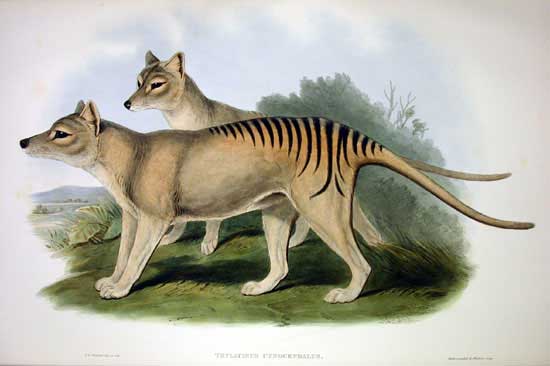The Tasmanian Tiger, or Thylacine, is a large, flesh-eating marsupial. Its head is like that of a dog and it has a very wide and powerful gape. The thylacine’s pouch opens backwards, therefore giving its young more protection when moving through the bush. It is sandy brown in colour and has a tail similar to a kangaroo. The base of its tail is thick and rigid. It has about 13 to 20 very distinctive dark brown stripes across the hind section of its body.
The thylacine is now believed to be extinct, although sightings of the animal continue to occur.
When Europeans came to Tasmania there were never great numbers of thylacines.

Europeans changed the habitat of the thylacine and that of its prey when they cleared parts of the land for farming and logging purposes. The construction of dams flooded thylacine habitat. Disease is also seen as contributing to the decline in thylacine numbers.
The thylacine did not hunt in packs but rather in pairs or on its own. It lived in hilly country with thick vegetation. It preferred to hunt at night, aided by its keen sense of smell.
It was also known to wear down prey it was stalking by sheer physical endurance. It found the sheep, introduced by Europeans, an easy prey. Any sheep losses were easily blamed on the thylacine.
In 1888 a bounty scheme was begun, the Tasmanian government paying trappers for the bodies of dead thylacines. By 1920 it was obvious that the thylacine was becoming an endangered animal but nothing was done to protect it. It wasn’t until 1936 that the thylacine was made a protected animal. By this time, it was too late. Ironically, the last thylacine in captivity died in 1936 at Hobart Zoo.
© Jim Low
